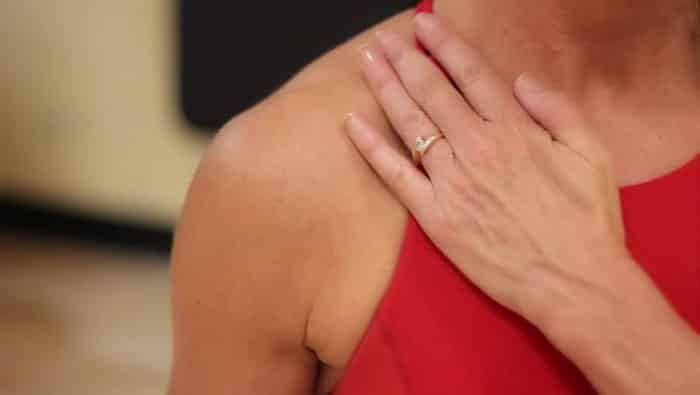
Pain in the collarbone
Collarbone pain and collarbone pain can be really painful and distressing.
Pain in the collarbone can be due to reasons such as muscle damage / myalgia, muscle tension, referred pain from the shoulder, loosening of the shoulder, joint locking, tendon damage, inflammation, nerve irritation in the neck and back - other diagnoses can be frozen shoulder or bursitis - but remember that it can also, in rare cases, be due to more serious problems. The collarbone is also often written as the collarbone. Feel free to contact us Facebook page our or via one of our clinic departments if you have any questions.
- The pain can stem from malfunctions and stiffness in the shoulders and neck
The collarbone is dependent on good function in the neck and shoulders. In the event of reduced mobility, stiffness and muscle tension, the basis for referred pain can be formed that continues towards the collarbone and in the part we call the shoulder arch (above the shoulder blade and the nape of the neck). We often see a clear connection between pain in the collarbone and in the shoulder.
- Where in your collarbone do you have pain?
Pain in the collarbone can occur on both the left and right side, and both on the innermost part towards the chest plate / sternum (this joint is also called the SC joint or is the sternoclavicular joint) and towards the outermost part closest to the shoulder (against the acromion in what we call the AC joint which stands for the acromioclavicular joint).
Our clinic departments at Vondtklinikkene (click here for a complete overview of our clinics), including in Oslo (Lambert seats) and Viken (Eidsvoll Sound og Raw wood), has a distinctively high level of professional expertise in the investigation, treatment and rehabilitation of shoulder complaints and referred muscle pain. Contact us if you want the help of therapists with expertise in these areas.
Did you know that several of the muscles in the shoulders and the transition of the neck can cause pain towards the collarbone? Just below in the article shows chiropractor Alexander Andorff produced a good training video with exercises that can give you stronger and more mobile shoulders, as well as help reduce collarbone pain.
VIDEO: Strength exercises for the shoulders and shoulder blades with training knit
Painful collarbones are often due to poor function in the shoulders and shoulder blades. Among the very most effective ways to train the shoulder muscles, we find training with rubber bands. Such training isolates the individual shoulder muscles and, with regular use, helps you regain functionality and relieve the collarbone. In this video we use flat, elastic training jersey (also called pilates band) - which is a training method we regularly recommend to our patients in rehabilitation training.
Join our family and subscribe to our YouTube channel for free exercise tips, exercise programs and health knowledge.
VIDEO: 5 Clothes Exercises Against Stiff Neck
Have you noticed how tense you are in your neck when you have a sore leg? This is because the neck and collarbone are directly affected by each other. This is why you should regularly focus on stretching your neck muscles as shown below.
Did you enjoy the videos? If you took advantage of them, we would really appreciate you subscribing to our YouTube channel and giving us a thumbs up on social media. It means a lot to us. Thank you very much!
Common Causes and Diagnoses of Collarbone Pain
First of all, it is important to state that the most common diagnoses are due to muscles and joints. Muscle tension, also known as myalgias, can in combination with joint restrictions (also known as facet joint locks) in the thoracic spine, the costal joints (the rib joints that attach to the thoracic spine), in the neck and the transition to the neck - especially trapezius, levator scapulae and pectoralis contribute to pain towards the collarbone.
- When the Pectoralis Major muscle causes collarbone pain

(Figure 1: Pain pattern from the pectoralis major chest muscle)
An overactive and shortened pectoral muscle can contribute to pulling the shoulder joint forward, which can give rise to loosening of the shoulder, which in turn will affect the collarbone. Pectoralis major has a pain pattern that can be felt on the front of the chest, but also occasionally in the front of the shoulder and further down the arm. Here it is important to mention that the pectoralis major does not become tense like this on its own - and that there is a high probability that there is reduced function in the shoulder on the same side. A good strategy would be to start with shoulder exercises and also physical treatment to dissolve the pain. A forward-leaning thoracic spine and forward neck position can also contribute to putting more strain on the collarbones.
– When the shoulder blade muscles affect the collarbone
In the shoulder we have four main stabilizers called the rotator cuff (The link opens in a new browser window). In case of reduced function i subscapularis, infraspinatus, supraspinatus and teres minor we can experience pain and discomfort in and around the shoulder, as well as towards the collarbone.
– Rotator cuff injuries
A common diagnosis that causes pain towards the collarbone is rotator cuff damage (tendon damage in the shoulder). This can involve muscle damage, muscle tension, tendinitis and tendon damage. Pain in the collarbone can also occur in combination with the diagnosis rib lock - which occurs when a joint gap in the thoracic spine, a so-called thoracic-costal joint, becomes very restrictive in movement with associated muscle tension.
This can cause sharp pain, within either the left or right shoulder blade, which almost goes through the back - from the back to the front - sometimes also towards the collarbone. If the pain is more localized to the outer part of the collarbone towards the shoulder, then one will often see an associated restriction and stiffness in the cervicothoracic joint (where the neck meets the sternum) and the shoulder - this will also cause local, high muscle tension in, among other things subscapularis musculature.
– Rare Diagnoses
More serious, albeit rare, diagnoses can be lung disease, pneumothorax (collapsed lung), metastasis (spread of cancer) or pulmonary embolism. These will also usually cause a number of other symptoms.
Reasons: Why do you get pain in the collarbone?
The most common is that the pain is caused by acute overload, prolonged improper loading, trauma (such as falls and accidents) or wear and tear (arthrosis). If there has been a fall from a bicycle or the like with subsequent collarbone pain, then it should be investigated for fractures or collarbone injuries with imaging (usually MRI examination or X-ray).
Self-measures and self-treatment against collarbone pain
Targeted rehabilitation training
Relaxation against the muscle points with a trigger point ball
More movement in everyday life
In order to get to grips with your own malfunctions that give rise to collarbone pain, it is important to carry out a thorough survey. Here, a clinician, such as a physiotherapist or modern chiropractor, can help you. Such a functional and clinical examination will also help you understand your body better, so that you know which muscles, joints, tendons and nerves are affected - or which should be treated and strengthened.
Tip 1: Targeted rehabilitation training with Elastic, Flat Pilates Band (The link opens in a new window)
Exercising with elastic bands is both gentle and effective. It can help you strengthen and activate the right muscles in and around the collarbone, as well as your shoulder blades. Click on the image or link to read more about how training with pilates bands can help you with your training.
- Don't forget relaxation for tight muscles and stress
In addition to proper training, relaxation is also important. In case of pain in the collarbone, it is particularly important to relax the muscles between the shoulder blades and chest muscles. For the chest muscles, you can roll one trigger point ball towards the muscles to stimulate blood circulation and to dissolve tense muscle fibres. Daily relaxation, approximately 10 to 30 minutes, in one trigger point mat with neck support can also be recommended.
Tip 2: Daily Relaxation with Trigger point mat with neck support (The link opens in a new window)
Taking time for yourself is incredibly important in a hectic everyday life. Over time, stress can manifest as severe muscle tension and pain. Therefore, please try to get a good routine daily use of massage mat (preferably 20-30 minutes). Feel free to combine it with breathing techniques or positive thinking therapy. Click on the image or the link to read more about how relaxation on a massage mat can help you with tension in the thoracic spine and collarbone areas.
Who gets hurt in the collarbone?
Acute Injuries
Prolonged failure load
Stress and Muscle Tension Over a Longer Time
Acute collarbone pain is particularly linked to trauma and falls. Cyclists have a nasty tendency to injure their collarbone when they fall off their bike - often due to an outstretched arm or the like. If, in addition to pain in the collarbone, you have chest pain and a family history of heart problems, it is a good idea to have an examination by your GP to check that everything is fine, just to be on the safe side. Fortunately, the most common cause is reduced function in nearby muscles and joints.
– Muscle tension and stress
It's a poorly kept secret that stress leads to muscle tension. This in turn leads, over time, to incorrect use of the muscles and associated joints, which can thus give rise to both pain and malfunction. So if you know that you have a hectic and stressful everyday life, and with no time for yourself at all, we strongly recommend that you make some changes in your everyday life. Because having such a high stress level over time is not good for either body or mind.
Where is the collarbone?
The collarbone is a bone that attaches the chest plate (sternum) to the shoulder blade. There are two collarbones, one on the left side and one on the right side. Let's take a closer look at the anatomy of the clavicle in the next part of the article.
Anatomy of the clavicle
In the illustration above we see the important anatomical landmarks around the collarbone. We see how it attaches both to the chest plate (sternum) and out to the shoulder blade via the acromion joint (AC joint). We take particular note of the shoulder joint and how shoulder function would be impossible without the important collarbone.
Muscles Around and on the collarbone
Seven muscles attach to the collarbone. Which in turn emphasizes the importance of keeping the shoulders and thoracic spine in optimal function. Address problems when they first arise, seek help from a clinician if you have pain, and you will often avoid it becoming long-term. The seven muscles that attach to the collarbone are the pectoralis major, sternocleidomastoid (SCM), Deltoid, trapezius, subclavius, sternohyoideus musculus and upper trapezius. Below in the picture we see where some of them attach to the collarbone.
There are also a number of joints that attach or are related to the collarbone- of the most important is the cervicothoracic junction (CTO), C6-T2 (which includes the two lower cervical vertebrae C6-C7 and the two upper thoracic vertebrae T1-T2). In the event of a lack of function in these, joint pain and associated myalgias in nearby muscle attachments can occur. Naturally, we must also not forget the SC link and the AC link.
Possible Causes and Diagnoses of Pain in the Collarbone
- Anxiety (can also cause increased muscle tension)
- Osteoarthritis (the pain depends on which joints are affected)
- Inflammation of the collarbone
- Soft tissue damage
- Bursitis / mucosal inflammation (subacromial)
- Deltoid (deltoid muscle) myalgia (pattern of pain going on front and back of shoulder)
- Frozen shoulder / adhesive capsulite
- Herpes zoster (follows the nerve pathway it affects and produces a characteristic rash in the dermatome of that nerve)
- Infraspinatus myalgia (pain that goes on the outside and front of the shoulder)
- Collar bone fracture
- Collar Bone Injury
- Joint locker / dysfunction in the ribs, neck, shoulder, sternum or collarbone
- Pneumonia
- lung Collapse
- Lung disease
- Muscle tension in the chest or chest
- Myalgia / myosis of the pectoral muscles
- Neuropathy (nerve damage may occur locally or further away)
- panic attacks
- Pectoralis minor myalgia (may cause pain towards the front of the shoulder and down the forearm)
- Pneumothorax (spontaneous lung collapse)
- Referred pain from the thoracic vertebrae
- rheumatism
- Rib muscles myalgia / myosis
- Rib joints (combined with active myalgia can cause pain deep inside the shoulder blades and collarbones)
- Rotator cuff damage
- Tendonitis
- tendon Dysfunction
- tendon Injury
- Scoliosis
- Shoulder blade fracture
- Shoulder Blades Damage
- Stretch the collarbone muscles
- Stress
- Subluxation of the collarbone (dislocated out of position)
- Acid reflux (esophageal disease / GERD)
- tendinitis
- Tendinosis
- Upper trapezius myalgia (can cause pain on the upper side of the collarbone)
Rare causes of pain in the collarbone
- bone cancer or any other cancer
- Infection (often with high CRP and fever)
- Influenza (can cause pain in almost the entire body including the collarbone)
- Cancer spread (metastasis)
- Pancoast syndrome
- Septic arthritis
- Synovitis
Possible reported symptoms and pain presentations for pain in the collarbone
- Acute pain in the collarbone
- Inflammation in collarbone
- Elimination in collarbone
- Burning in collarbone
- Deep pain in collarbone
- Electric shock in collarbone
- The right collarbone is hurt
- Hogging in collarbone
- Intense pain in collarbone
- Fucking in collarbone
- Knot i collarbone
- Cramps in collarbone
- Prolonged pain in collarbone
- Joint pain in collarbone
- Locked in collarbone
- Mooring i collarbone
- Murmuring in collarbone
- Muscle pain in collarbone
- Nervous pain in collarbone
- The name i collarbone
- Tendonitis in collarbone
- Shake in collarbone
- Sharp pains in collarbone
- Leaning in collarbone
- Worn in collarbone
- Stitching in collarbone
- Steal in collarbone
- Wounds in collarbone
- The left collarbone is hurt
- Effect i collarbone
- Sore in collarbone
Investigation and Investigation of Pain in the Collarbone

Functional Examination of the Collarbone and Shoulders
Imaging Diagnostic Examination (if medically indicated)
Functional Investigation
During an initial consultation with us at The pain clinics The clinician will first start by taking a history of your symptoms and pain. You then proceed to examine the function in and around the collarbone - which will then include examination of the neck and shoulders. Often, with collarbone problems, you will have findings such as reduced movement in the shoulder and neck - or significant muscular tension. Joint restrictions in the thoracic spine and between the shoulder blades can also be a strong contributor to such ailments.
Prevention of Pain in the Collarbone
Take pain and malfunction seriously - seek expert help.
Look for well-being in everyday life, and take time for yourself.
Work with a good sleep rhythm and good bedtime routines.
Regular movement (daily walk for example).
Training of shoulders and shoulder blades with elastic
Image Diagnostic Investigation
Sometimes it may be necessary imaging (X, MR, CT or diagnostic ultrasound) to determine the exact cause of the problem. Normally, you will manage without taking pictures of the collarbone, but it is relevant if there is a suspicion of injury, fracture or serious pathology. Below you can see various pictures of how the collarbone looks in the different examination forms.
VIDEO: MR Shoulder and Collarbone (Normal MRI Survey)
MR description:
“R: Nothing pathologically proven. No discoveries. "
Explanation: This is a composition of MRI examination images from a normal shoulder without MRI findings. The shoulder was sore, but there were no injuries visible in the pictures - it turned out later that the pain came from joint restrictions in the neck and thoracic spine, as well as active muscle knots / myalgias in the rotator cuff muscles, upper trapz, rhomboidus and levator scapula. The solution was stabilizing rotator cuff training (see exercises), chiropractic joint correction, muscle therapy and specific home exercises. Thank you for sharing such photos with us. The photos are anonymized.
MRI image of the shoulder (axial section)

MRI OF SHOULD, SHORT CUT - PHOTO WIKIMEDIA
Explanation of the MRI image: Here you see a normal MRI of the shoulder, in an axial section. In the picture we see the infraspinatus muscle, scapula, subscapularis muscle, serratus anterior muscle, glenoid, pectoralis minor muscle, pectoralis major muscle, coracobrachialis muscle, anterior labrum, the short head of the biceps tendon, the deltoid muscle, the long head of the biceps tendon , the deltoid muscle, the head of the humerus, the teres minor tendon and the posterior labrum.
MRI image of the shoulder and collarbone (coronal section)
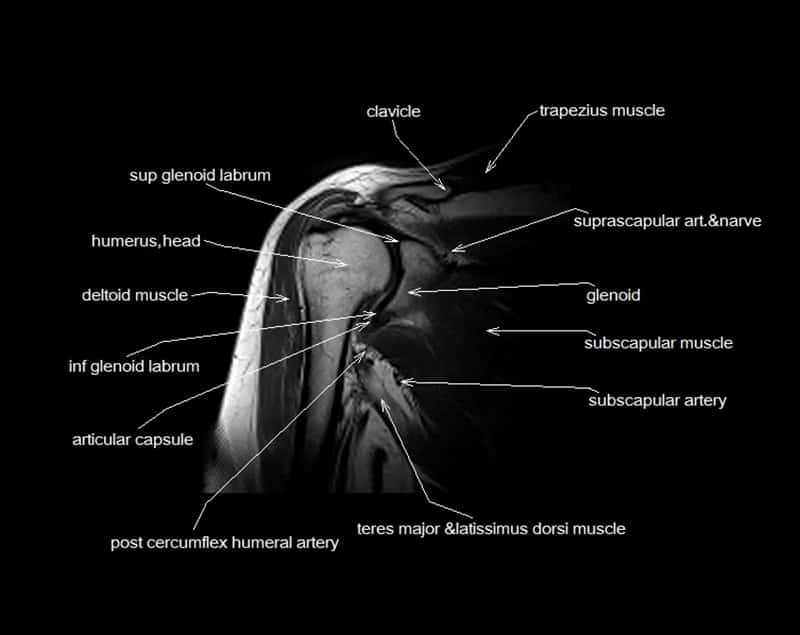
MRI of shoulder, coronal cut - Photo Wikimedia
Explanation of MR image: Here you see a normal MRI of the shoulder, in a coronal section. In the picture we see the teres major muscle, the latissimus dorsi muscle, the subscapular artery, the subscapular muscle, the glenoid, the suprascapular artery and the suprascapular nerve, the trapezius muscle, the clavicle, the upper labrum, the head of the humerus, the deltoid muscle, the lower labrum, the articular capsule and the humeral artery.
X-ray of shoulder and collarbone
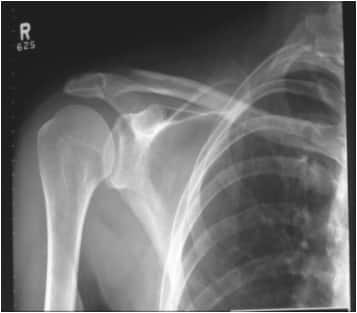
Description of the shoulder X-ray: Here we see an image taken anterior to posterior (taken from front to back).
Diagnostic ultrasound examination of the shoulder and collarbone
Description of the ultrasound examination image of the shoulder: In this image we see a diagnostic ultrasound examination of the shoulder. In the picture we see the biceps tendon.
CT of the shoulder and collarbone
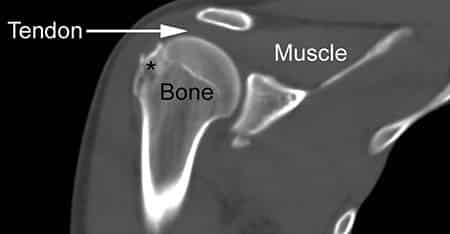
Description of the CT examination image of the shoulder: In the image we see a normal shoulder joint.
Treatment of Pain in the Collarbone
Conservative, Physical Treatment
Invasive Treatment (Surgery)
Physical Treatment
These are non-invasive forms of treatment that aim to process and treat malfunctions in muscles, tendons, connective tissue, nerves and joints. In such treatment, the clinician, often a physiotherapist or chiropractor, combines various treatment techniques to achieve recovery. When treating collarbone ailments, this can include, among other things:
- Graston (tendon tissue tool)
- Intramuscular acupuncture (to dissolve tension)
- Laser therapy (MSK)
- Joint mobilization (to increase joint mobility)
- Muscular techniques
- Muscle knot treatment (trigger point treatment)
- Specific rehabilitation training (preferably with elastic band)
- Traction
- Pressure wave therapy (for certain shoulder diagnoses)
A clinician will select treatment modalities based on findings from the clinical examination. For example, with significant stiffness in the shoulder joint, there will naturally be a greater focus on shoulder joint mobilization and traction, to promote more movement and better spatial relationships. But it is important to work holistically – with both muscles, tendons and joints in combination.
Invasive Treatment (Injections and Surgery)
What defines invasive treatment methods is that there is an increased risk. Operations and pain injections are some of the invasive forms of treatment that you want to stay away from, but in certain cases they are necessary. For example, in the case of a collarbone fracture, it is necessary to operate on the bone in place (if it is a complicated fracture), so that it heals correctly. With invasive techniques, the risk is always weighed against the possible gain.
– Surgical intervention: Cyclist with collarbone fracture
In this example, a cyclist was unlucky and broke his collarbone - he had to have surgery. Here you can see the before and after picture. The orthopedic surgeons had to operate on a titanium plate with 7 screws to ensure that the fracture healed properly. Can you imagine what that collarbone would look like if you hadn't operated on it? It had not looked pretty. But it can probably also be expected that this cyclist will have to live with some discomfort from the surgery in the future.
- Pain clinics: Our clinics and therapists are ready to help you
Click on the link below to see an overview of our clinic departments. At Vondtklinikkene Tverrfaglig Helse, we offer assessment, treatment and rehabilitation training, for, among other things, muscle diagnoses, joint conditions, nerve pain and tendon disorders.
Frequently asked questions regarding Collarbone pain (FAQ)
Feel free to use the comments section below to ask questions. Or send us a message via social media or one of our other contact options.
Target: Cause of sudden pain in the collarbone towards the shoulder?
As mentioned, there are a number of possible causes and diagnoses for pain in the collarbone towards the shoulder on the left or right side - the symptoms must be seen in full. However, among other things, referred pain from nearby muscle dysfunction or joint restrictions (in the neck, thoracic spine, ribs and shoulder) can cause pain in the collarbone. Frozen shoulder and subacromial bursitis are also two relatively common diagnoses. Other more serious causes are lung disease and many other diagnoses. See list higher up in the article. If you elaborate on your concerns in the comments section below, we can do more to help you.
Question: Cause of pain on the innermost part of the collarbone towards the chest?
In case of dysfunction in muscles and joints, pain can occur in the SC joint (known as the sternoclavicular joint), this is the area where the collarbone attaches to the chest. This can also cause high overactivity in pectoralis (chest muscle) and can give pronounced pressure when pressing the collarbone. Such pain occurs almost always in combination with impaired joint function in the neck, chest and / or shoulder.
Q: Can foam rolling help my collarbone pain?
Yes, a foam roller and muscle knot balls can help you to some extent with stiffness and myalgias, but if you have a problem with the collarbone, we recommend that you contact a qualified healthcare professional in the musculoskeletal field and get a qualified treatment plan with associated specific exercises - most likely you will also need joint treatment to normalize the condition. A foam roller is often used against the back of the chest to increase circulation in the area. We otherwise recommend that you go for daily walks with good arm swing to keep your blood circulation up - there are no shortcuts to good health.
Question: Why do you get pain in the collarbone?
Pain is the body's way of saying that something is wrong. Thus, pain signals must be interpreted as a form of dysfunction in the area involved, which should be investigated and further improved with appropriate treatment and training. Causes of collarbone pain can be due to sudden strain or gradual strain over time, which can lead to increased muscle tension, joint stiffness, nerve irritation and, if things have gone far enough, damage to joints and tendons.
Question: Woman, 40 years old, asks - what should be done with a painful collarbone full of muscle knots?
Common muscle tension against the collarbone can, among other things, originate from the chest muscles and shoulder muscles. muscle knots has most likely arisen due to an incorrect balance in the muscles or incorrect loading. There may also be associated muscle tension around joint restrictions in the nearby thoracic spine, ribs, neck and shoulder joints. In the first instance, you should get qualified treatment, and then get specific exercises and stretching so that it does not become a recurring problem later in life. You can also use the following exercises to Exercise chest and shoulder stability. Contact us here or on our Facebook page if you want more tips and exercises.
Relevant questions with the same answer: Can you have a muscle knot in the collarbone?
References, Research and Sources:
Cox et al (2012). Chiropractic management of a patient with lumbar spine pain due to synovial cyst: a case report. J Chiropr Med. 2012 Mar; 11 (1): 7–15.
Kalichman et al (2010). Dry Needling in the Management of Musculoskeletal Pain. J Am Board Fam MedSeptember-October 2010. (Journal of the American Board of Family Medicine)
Bronfort et al. Spinal Manipulation, Medication, or Home Exercise With Advice for Acute and Subacute Neck Pain. A Randomized Trial. Annals of Internal Medicine. January 3, 2012, vol. 156 no. 1 Part 1 1-10.
Images: Creative Commons 2.0, Wikimedia, WikiFoundy, Ultrasoundpaedia, LiveStrong
Other popular search phrases for this article: Collarbone pain, collarbone pain





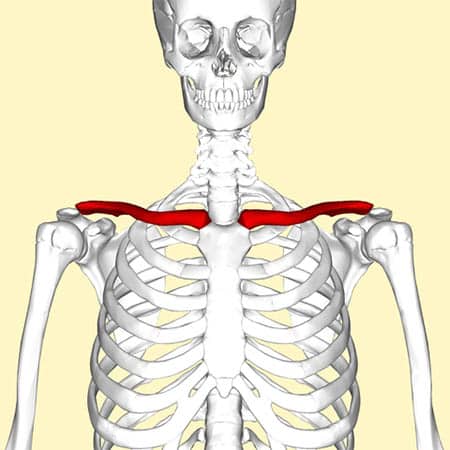





Leave a reply
Want to join the discussion?Feel free to Contribute!